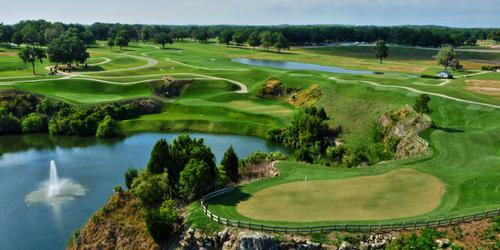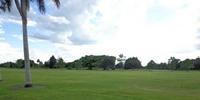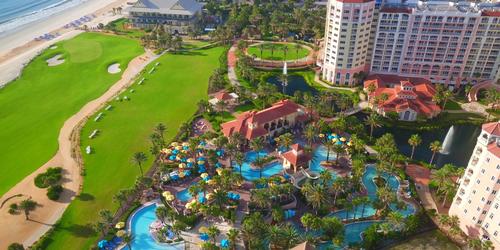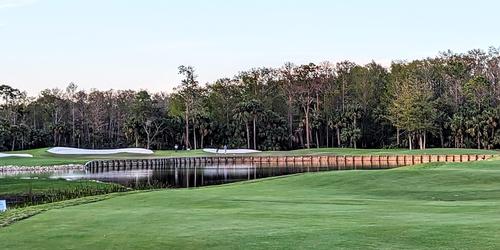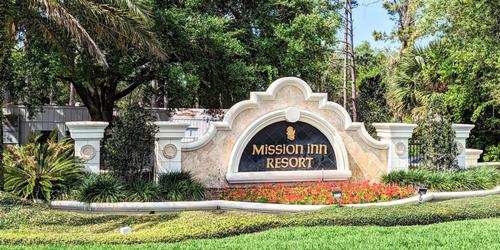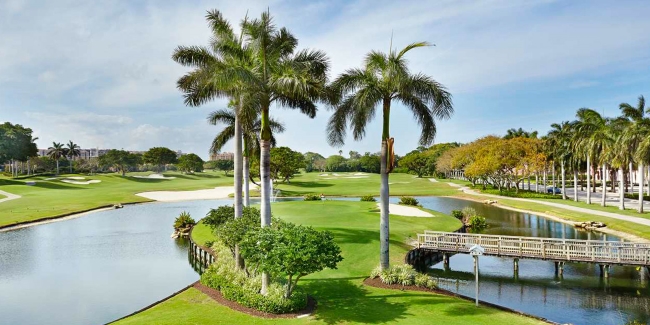
Golf at The Boca Raton Resort & Club
Living Breathing History
By Mike May
When you step foot on the Resort Course at the world-famous Boca Raton Resort & Club, it's truly a yesteryear atmosphere and experience. Today's golf courses are simply not designed like this one anymore. And, that's too bad. When standing on the first tee, you can almost imagine some of the game's great names from the past walking by and playing through as they once did on a regular basis. Based on the pure beauty of the course, some might consider it a 'millionaire's playground.' And, truth be told, it was at one time, 'back in the day.'
To truly appreciate the Resort Course at the Boca Raton Resort & Club, a Waldorf Astoria Resort, it's best to follow the roots of local history.
In 1925, Boca Raton was founded. A year later, golf was being played in Boca at the Cloister Inn, now the site of the Boca Raton Resort & Club. Soon after Boca Raton officially became a community, city leaders asked renowned architect Addison Mizner to design a world-class resort in Boca. Mizner then hired legendary Scottish golf course designer Donald Ross to oversee the construction of a golf course which was built on both sides of the nearby El Camino Real Road - with 13 holes north of the road and five holes south of the road.
Upon completion, a story in the local newspaper made a profound observation about Ross' creation: "The Cloister Inn Golf a Course has been literally snatched from the jungle."
The jungle reference was accurate since south Florida in the 1920s was dominated by marshland, palmetto bushes, and thick vegetation.
In 1927, Clarence Geist acquired the Cloister Inn and the golf course. He then hired two golf course designers -- Howard Toomey and William Flynn -- to take what Ross had built and re-design two new 18-hole courses. The North Course, as they named it, was completed with all 18 holes located north of the El Camino Real Road.
Fast forward to 1997 when golf course architect Gene Bates completely re-designed the layout of what is now the Resort Course at the Boca Raton Resort & Club, which is now listed on the Florida Historic Golf Trail. During his work, Bates was aware of the importance of blending the present with the past.
"To maintain the historical significance of the course, we fashioned many of the tees and bunkers to their original design," said Bates. "However, we transformed the fairways and greens to be much more demanding. Each hole offers five sets of tees, providing a well-rounded resort golf experience."
Today's course (par 71) is not long -- just over 6,200 yards from the back tees (gold tees) - but it is cleverly designed. The Resort Course is proof positive that length is not necessary for a course to have a certain degree of difficulty. It's also appealing to the eye as a number of beautiful flowers, plant life, and shrubs dominate the landscape of the course. Since it's south Florida, water is never out of sight, thanks to the existence of 12 acres of lakes. A 'watery grave' is usually one swing away. Elevation changes are not a major issue, as the highest point on the course is 30 feet above sea level, but there are enough subtle changes in the course's terrain to leave you in between clubs at times.
At this course, it's possible to post a great score, but the existence of many well-placed fairway sand bunkers is another ongoing concern on nearly every tee shot.
Four of the biggest visual 'takeaways' from any round at the Boca Resort will be the tee shots on the 3rd, 12th, 18th holes,.....and the entire 16th hole. The fairways of the 3rd and 12th holes are bordered by colorful flowers and shrubs. While standing on the 18th tee, especially the back tees, you see an island green in the distance with a water fountain to the right of the green shooting water high into the sky. The 16th hole is a par five where water hugs the left side of the fairway from tee to green. You must cross portions of the water on two occasions to reach the green. It's easy to see why the 16th is rated as the course's most difficult hole.
"Simply put, this course can be conquered with strategy and not strength," says Jimmy Gascoigne, head golf professional at the Boca Resort, who adds that golfers must stay at the Resort or be members of the Boca Resort to play here.
As soon as you walk off the 18th green, head to the locker room for a shower and a change of clothes. And, then enjoy a post-round sandwich and a drink under the canopy at Mulligan's, which is located just outside the entrance to the locker rooms.
Two of the pictures in the men's locker room which were interesting were pictorial tributes to the evolution of the golf ball and the golf club.
The golf ball portrait showcased pictures of the feathery ball (c1840s); smooth guttie (c1850); hand hammered guttie (c1850); park royal 56 sided (1896); the Spalding remade recovered (c1900s); and the mesh marked rubbercore (1930).
The golf club portrait had images of the putter, niblick, driving iron, mid-iron, spoon, and the driver.
In 1987, the Resort Course was dedicated to a pair of golfing 'heavyweights,' who served as golf professionals at the Resort, 'back in the day' -- Scotland's Tommy Armour (aka, 'The Silver Scot') from 1926 to 1955 and Virginia's 'Slammin' Sammy Snead from 1956 to 1969. By the way, Armour charged $50/lesson, but I'm not sure what Snead's fee was for a private lesson at the Boca Resort. By the way, one of Armour's pupils was the great Babe Didrikson Zaharias.
When you get the chance to play the Resort Course (501 East Camino Real, Boca Raton, FL; 888-543-1277; www.bocaresort.com, remember that you are truly 'walking' through the pages of South Florida history -- just as Mizner, Ross, Armour, and Snead did, 'back in the day.'
FYI: About the Boca Raton Historical Society & Museum: The Boca Raton Historical Society & Museum is a non-profit membership organization dedicated to preserving the past to enrich the future. The museum actively promotes historic preservation and education through its history museum, guided tours, and educational programs. The Boca Raton History Museum is located in the historic Town Hall, 71 North Federal Highway. Hours are M-F 10-4 and admission is $5 for adults, $3 for students and free to members. For more information or to become a member, go to www.bocahistory.org, or call 561-395-6766.
Revised: 10/28/2015 - Article Viewed 29,358 Times
About: Mike May
![]() Mike May is a Wellington, Florida-based freelance golf and sportswriter, who is also a 25+ year public relations and communications executive in the sporting goods industry. He is also a veteran high school soccer official, an experienced high school basketball coach, an avid athlete, a part-time personal trainer, and a passionate golfer who is forever in pursuit of Old Man Par. He is a member of the Golf Writers Association of America.
Mike May is a Wellington, Florida-based freelance golf and sportswriter, who is also a 25+ year public relations and communications executive in the sporting goods industry. He is also a veteran high school soccer official, an experienced high school basketball coach, an avid athlete, a part-time personal trainer, and a passionate golfer who is forever in pursuit of Old Man Par. He is a member of the Golf Writers Association of America.
Contact Mike May:
GolfTrips.com - Contributor





